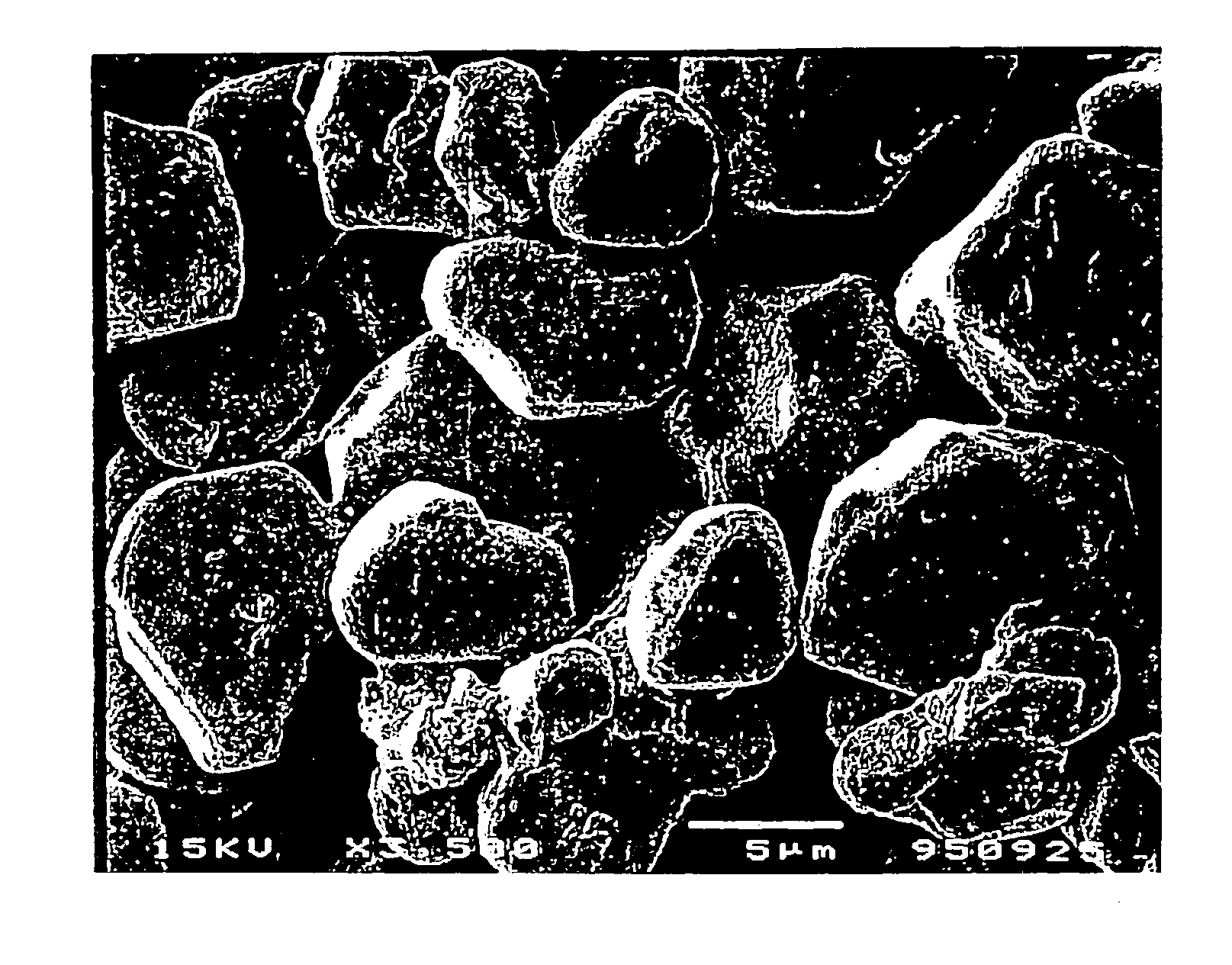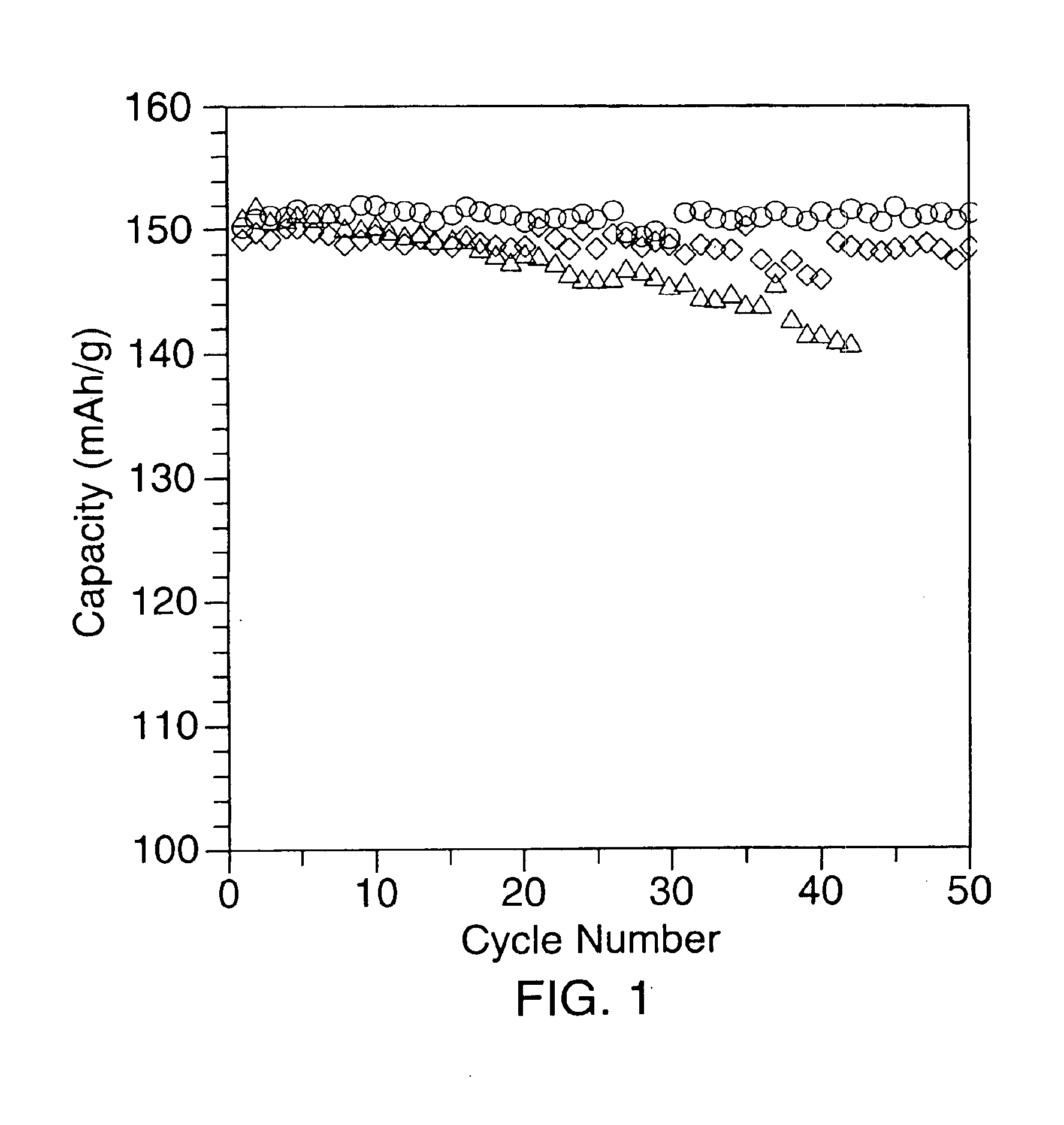Electrode material for rechargeable batteries and process for the preparation thereof
a lithium ion battery and electrode material technology, applied in the direction of positive electrodes, nickel compounds, inorganic chemistry, etc., can solve the problems of high capacity, high cost of lithium nickel dioxide, thermal instability, etc., and achieve high reversible capacity
- Summary
- Abstract
- Description
- Claims
- Application Information
AI Technical Summary
Benefits of technology
Problems solved by technology
Method used
Image
Examples
example 1
[0042]Uncoated lithium nickel dioxide (termed sample 1) was prepared in accordance with the following method. 463.5 g of Ni(OH)2, 230.7 g of LiOH.H2O and 35.1 g of KOH (containing about 15% water therein) were admixed using a mortar and pestle, providing an atomic ratio of Ni:Li:K of 1.0:1.1:0.11. The mixture was then heated at 750° C. for 2 hours in a stream of oxygen. After heating, the material was washed with water to remove KOH and excess LiOH, and placed in an oven at 150° C. for 4 hours to remove the water. The material was ground and passed through a 400 mesh screen (Tyler Series) to provide LiNiO2 powder having a particle size of about 10 microns as measured by Microtrac™. The SEM results demonstrate that the particles of approximately 10 microns size were crystalline as shown in FIG. 4a.
example 2
[0043]A first coated lithium nickel dioxide compound, (referred to hereinafter as sample 2), was prepared using the following procedure. 25 g of LiNiO2 (sample 1) was mixed with a water solution containing 2.5 g of Co(NO3)20.6H2O and 0.825 g of LiNO3 to form a slurry having a mole ratio of LiNiO2:Co(NO3)2.6H2O:LiNO3 of 1.0:0.033:0.046. The slurry was stirred and heated to about 120° to remove water. The material was then placed in a furnace and heated at 750° C. for 2 hours in a stream of oxygen. Following the heat treatment step, the material was ground and passed through a 400 mesh screen. SEM observations showed that there were no major differences in particle size between samples 1 and 2 (Compare FIGS. 4a and 4b). However, surface modification of the particles was observed. Approximately 3.3% cobalt content by weight versus total nickel content was thought to be present on the surface. The conventional layered LiCoO2 (a=0.2814 nm, c=1.408 nm) was not observed by X-ray diffractio...
example 3
[0044]A second coated lithium nickel dioxide (sample 3) was prepared using the procedures outlined in example 2. 25 g of sample 1 were mixed with a water solution containing 0.25 g of Co(NO3)20.6H2O to prepare a slurry having a LiNiO2:Co(NO3)2.6H2O ratio of 1.0:0.0033. As with sample 2, surface modification was effected. The surface cobalt content was thought to be approximately 0.33% (mole ratio).
PUM
 Login to View More
Login to View More Abstract
Description
Claims
Application Information
 Login to View More
Login to View More - R&D
- Intellectual Property
- Life Sciences
- Materials
- Tech Scout
- Unparalleled Data Quality
- Higher Quality Content
- 60% Fewer Hallucinations
Browse by: Latest US Patents, China's latest patents, Technical Efficacy Thesaurus, Application Domain, Technology Topic, Popular Technical Reports.
© 2025 PatSnap. All rights reserved.Legal|Privacy policy|Modern Slavery Act Transparency Statement|Sitemap|About US| Contact US: help@patsnap.com



